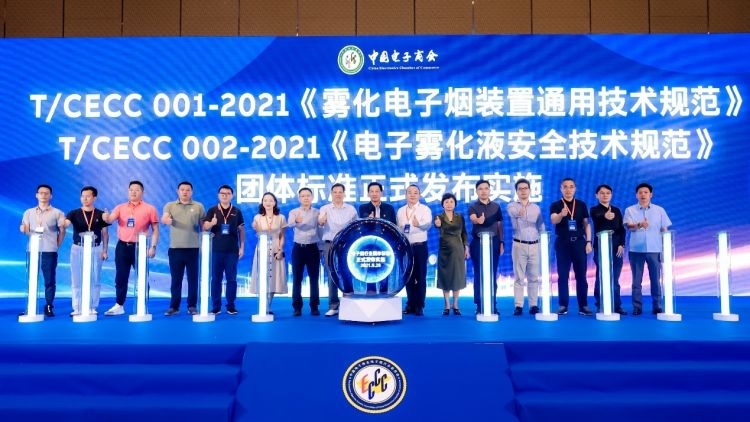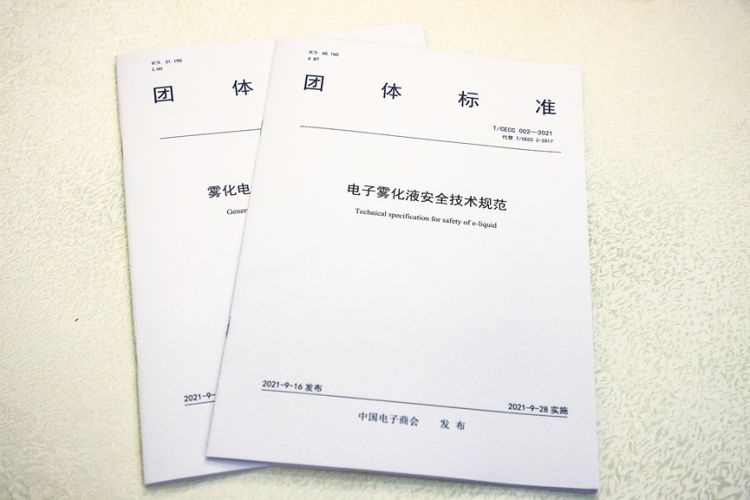On September 28, the China Electronic Chamber of Commerce officially updated and released two group standards, "General Technical Specifications for Atomizing Electronic Cigarette Devices" and "Safety Technical Specifications for Electronic Atomizing Liquids" (hereinafter referred to as "Group Standards").
Compared with the previous regulations, the new version of the "Group Standards" has added a number of physical and chemical test indicators and test methods, put forward a "banned substance list" for atomizing liquid, and formulated more clear safety requirements for electronic cigarettes.
Wang Yiqun, director of the Industrial Standards Innovation Institute of Shenzhen Institute of Standards and Technology and a professor-level senior engineer, said that the standard is more stringent than the EU and US standards in the detection of banned substances, heavy metals and other harmful substances, and will promote the healthy and orderly development of the industry.
Refer to the regulations of many countries and regions to improve the new group standard
China is the world's leading producer of vaping e-cigarettes. According to data released by the Electronic Cigarette Industry Committee of the China Electronic Chamber of Commerce, more than 90% of the world's electronic cigarettes are produced in Shenzhen, Guangdong.
At present, the domestic mandatory standards for electronic cigarettes have not yet been issued, and the group standards have thus become an important basis for guiding the production of enterprises. The China Electronic Chamber of Commerce released the first domestic e-cigarette group standard in 2017. On this basis, the revised "Group Standard" refers to the regulations of France, the United Kingdom, the United States, the European Union and other countries and regions, integrates the "EU Tobacco Directive" and relevant domestic requirements, and adds a number of testing contents.
In the quality inspection of atomized liquid, the "Group Standard" has added physical and chemical indicators such as "relative density, refractive index, viscosity, acid value, pH value", which can more comprehensively test the atomized liquid and ensure quality stability.
Release is one of the important indicators for evaluating the safety of electronic cigarettes. For the first time, the "Group Standards" stipulates the limits of the release components. For example, the total content of the four tobacco-specific nitrosamines shall not exceed 0.5 ng / mouth, and the content of bisphenol A shall not exceed 0.33 ng / mouth.

▲The release ceremony of "Group Standards" was held in Shenzhen.
"We hope to improve the level of industry development through better group standards," said Ao Weinuo, secretary general of the Electronic Cigarette Industry Committee of China Electronic Chamber of Commerce, "We also encourage leading companies to implement stricter corporate standards on top of group standards, and lead the way. global industry development."
Launched the "Prohibited Substances List" for nebulizers and set a safety bottom line
Atomizing liquid is the core of the quality and safety of electronic cigarettes, and it will also directly affect the taste experience of electronic cigarettes. At present, most countries and regions in the world use the "Prohibited Substance List" system to manage the added components of electronic atomizing liquids.
Based on the European Union, the Middle East and other regional standards, the "Group Standards" has formulated a more stringent and comprehensive "banned substance list", covering 40 categories, including all carcinogens, mutagens, reproductive toxicity substances, and coffee. Psychoactive substances such as caffeine and taurine.
Compared with overseas standards, the French standard does not limit the content of benzene series, and the "Group Standard" requires that benzene should not exceed 0.2 mg per kilogram of atomized liquid; EU, Middle East, Australia and other standards do not restrict sugars and preservatives. The Group Standards have included these two items in the list; the standards for testing items such as heavy metals are also stricter than overseas.

▲ Two newly released "Group Standards".
Wang Weijun, a senior engineer and doctoral supervisor of the Shenzhen Institute of Advanced Technology, Chinese Academy of Sciences, said that the "Prohibited Substance List" is in line with the supervision and management of major countries in the world and is highly flexible. Once new banned substances are discovered, they can be included in the list at any time, which is convenient for supervision. The department has targeted detection of specific substances.
Ao Weinuo said that the "mysterious pneumonia" and "top e-cigarettes" that have attracted widespread attention have all been confirmed to be caused by illegally added substances. The "Prohibited Substance List" can help supervise the rapid detection of products, improve management efficiency, and set a safety bottom line for e-cigarette products.
Mark "No sales to minors" and add child protection features
According to reports, the main author of "Technical Specification for Safety of Electronic Atomization Liquid" is Shenzhen Institute of Metrology and Quality Inspection, and the main author of "General Specification for Electronic Atomization Appliance Products" is Shenzhen Foxin Technology Co., Ltd. and Shenzhen Microwell Technology Co., Ltd. . The evaluation expert group is from Shenzhen Institute of Standards and Technology, Shenzhen Customs Industrial Products Technology Testing Center, China Quality Certification Center, Shenzhen Advanced Technology Research Institute of Chinese Academy of Sciences, Sun Yat-sen University and other research institutions.
This "Group Standard" also updated the minors protection clause, requiring the warning language or warning graphic symbol of "Prohibition of sales to minors" to be marked on the outer packaging of the atomizer.
In addition, the open-type atomizing electronic cigarette device should have a protective function to prevent children younger than 52 months from opening it and avoid accidental ingestion of electronic atomizing liquid due to improper operation. This provision can further strengthen the line of defense and cut off the possibility of minors purchasing or misusing.
With the rapid development of the electronic atomization industry, the huge consumer demand has also put forward higher requirements and challenges for related enterprises. Ao Weinuo said that the update and release of the "Group Standards" will further regulate the production and sales of domestic e-cigarettes, and will also help to establish and improve a long-term supervision mechanism for e-cigarettes, ultimately realizing that good money drives out bad money, and enhances the social responsibility of related companies. .
Article source: Shenzhen Evening News
Original link: https://app.myzaker.com/news/article.php?pk=6152fa261bc8e0f90f000207


